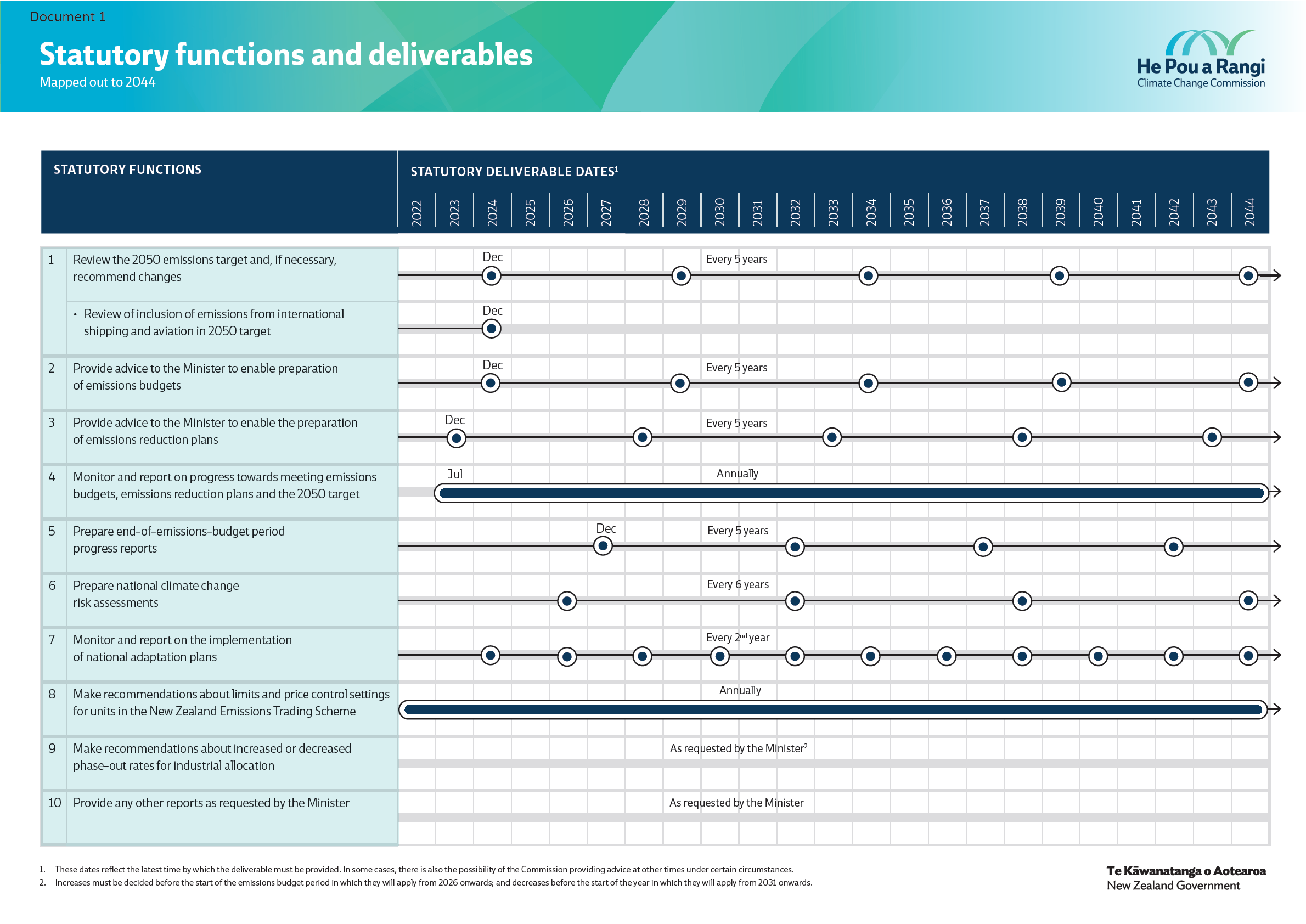

Document 4
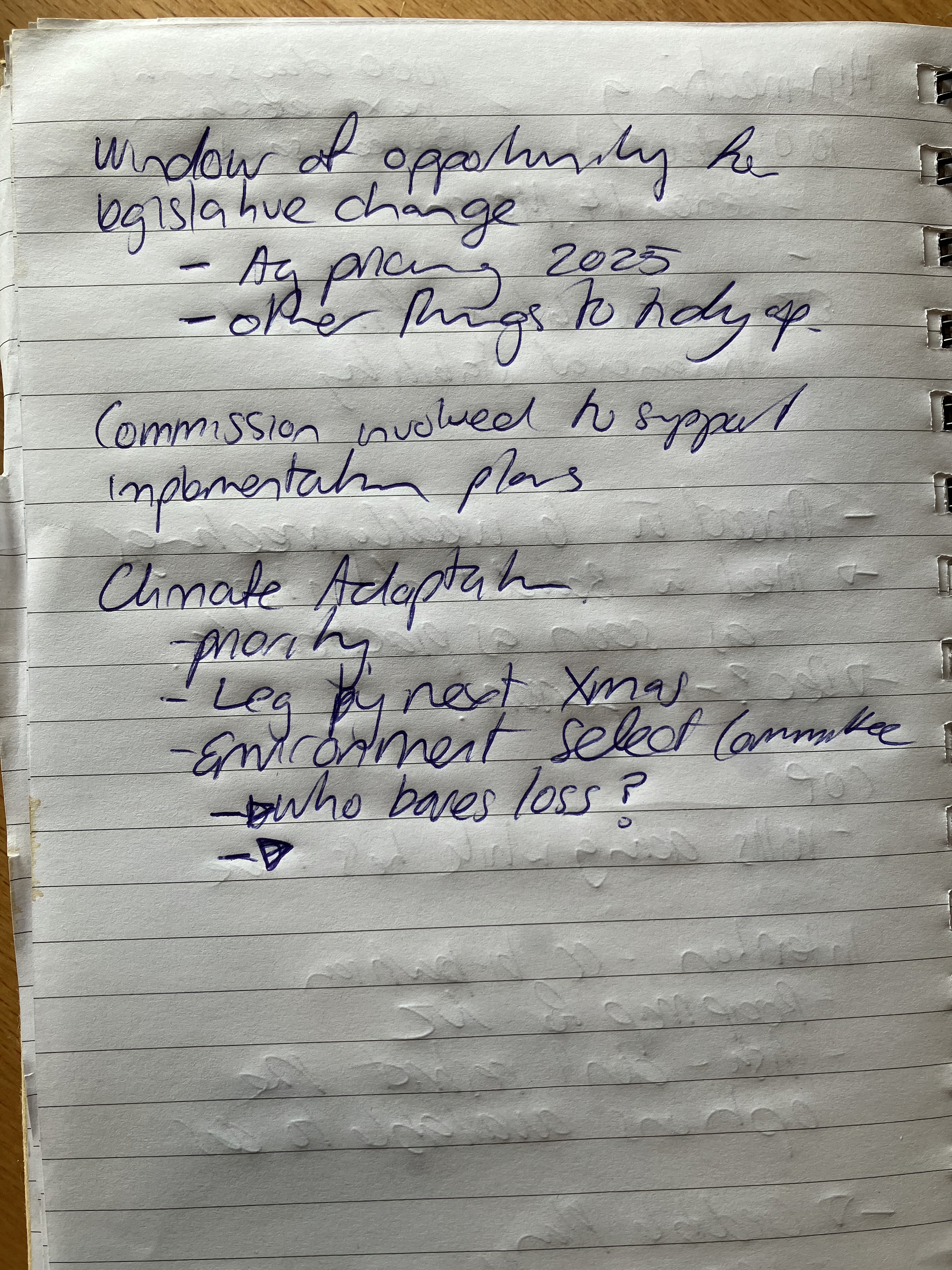
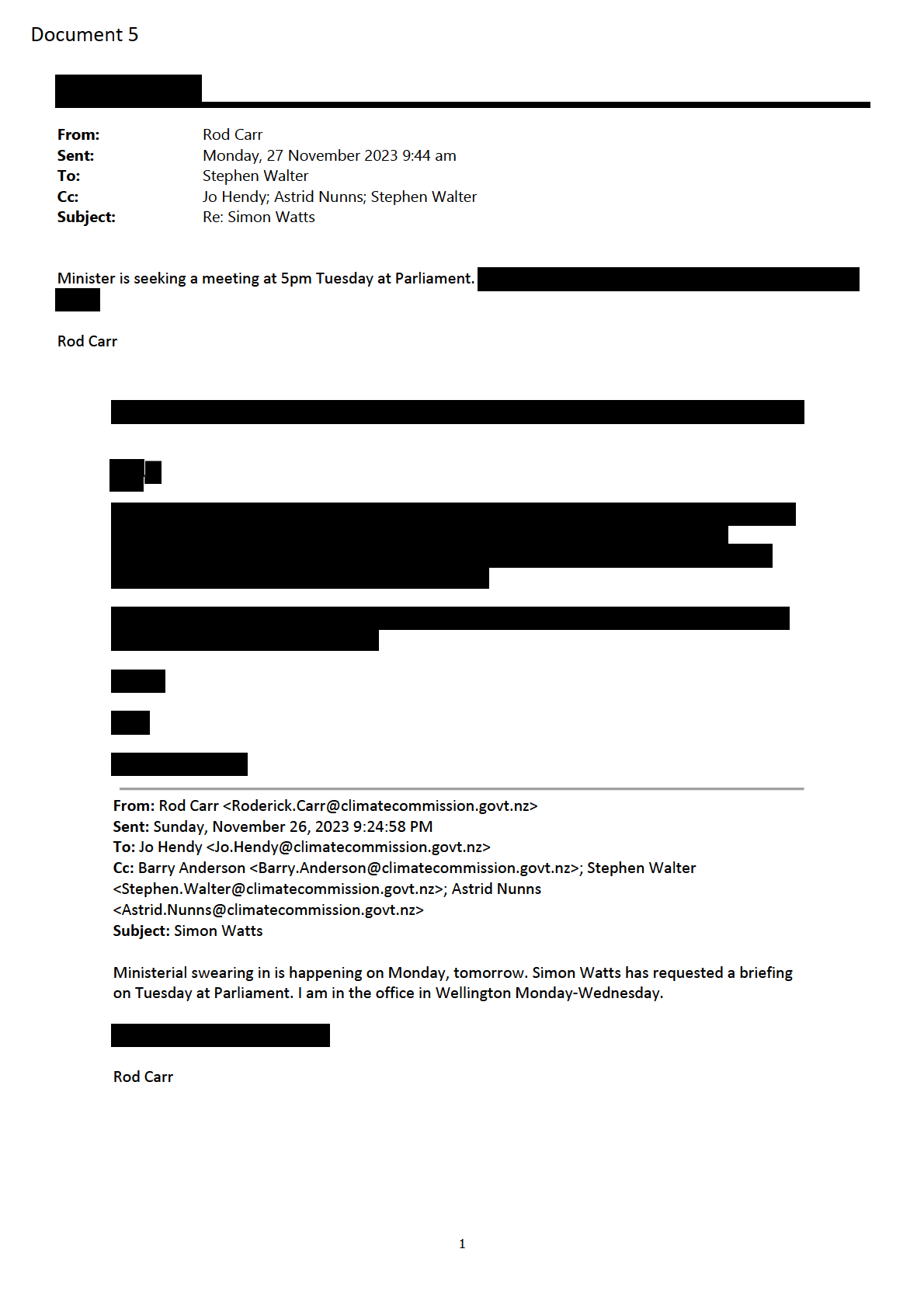


 To:
To: Grant Blackwell <[email address]>; Marcus Stickley
<[email address]>; Stuart Dymond <[email address]>
Cc: Alexandra Aimer‐Seton <[email address]>; Sophie Carroll
<[email address]>
Subject: RE: Rod briefing with Minister tomorrow
Hi Grant,
Thanks for this. Who will be accompanying Rod? Marcus is going to take the lead on pulling some briefing material
together, working from the ERP prep, draft BIM and – if needed – annual review materials as they currently stand.
Cheers, Fran
From: Grant Blackwell <[email address]>
Sent: Monday, 27 November 2023 9:54 am
To: Fran Lovell <[email address]>; Marcus Stickley
<[email address]>; Stuart Dymond <[email address]>
Cc: Alexandra Aimer‐Seton <[email address]>
Subject: Rod briefing with Minister tomorrow
Mōrena koutou
Rod is in town this week and has just informed me that the Minister has asked for a briefing with him tomorrow. I
understand the purpose is for an introductory meeting, although any topic could be covered.
I will leave it in your capable hands to pull together some briefing material and a comms plan for Rod. I understand
Rob Carr has pulled together some bullet points that could be helpful in prepping for the session, but could you
please loop back to Rob to make sure his is comfortable with them being used for the preparation?
Rod is giving a presentation this morning, but has time this afternoon to prep.
It also makes getting the ERP2 advice to the Minister today the highest priority, so he has received that ahead of the
meeting.
Let me know if you need any further information or support.
Ngā mihi
Grant
Dr Grant Blackwell |
Kaipūtaiao Matua
Chief Science Adviser
M 022 033 9831
E [email address]
W climatecommission.govt.nz
2
Document 7
From:
Jo Hendy
Sent:
Tuesday, 28 November 2023 9:28 am
To:
Marcus Stickley
Cc:
Grant Blackwell
Subject:
RE: New Minister briefing - prep doc
Grant/Marcus –
It would be useful to have some key numbers at hand – I’ll want this for launch day anyway. Easy to memorise ones
that don’t need to be exactly these but touch on the topic, e.g:
1. Amount of reduction over EB2 in Mt
2. How much we are going to miss in Mt
3. Health benefit $$ of reducing emissions
4. GDP – cost of delay
5. Forest expansion to date
6. Forest expansion in our to 2050
7. $ investment in renewables (BCG report)
8. $ payoff from lower energy bills (ERP2)
9. GWs of new renewables needed by 2030, 2050, rate increase per year
10. EVs now and needed by 2030
11. Cost containment reserve price
12. Current NZU price
13. Percentage of emissions outside of ETS, and covered by free allocation
Thanks,
Jo
From: Marcus Stickley <[email address]>
Sent: Tuesday, 28 November 2023 8:39 am
To: Jo Hendy <[email address]>
Cc: Grant Blackwell <[email address]>
Subject: Fwd: New Minister briefing ‐ prep doc
Mōrena Jo,
Here's the prep pack that went to Rod yesterday. I need to make some minor changes off the back of the prep
meeting and will get the updated doc out later this morning.
Rod will take over 10 copies of ERP2, 2 copies of the Commission's Annual Report and an A3 showing the
Commission's upcoming work (the chart that was in Inaia tonu nei is getting a spruce up.)
Let me know if you have any questions.
Cheers!
Get Outlook for iOS
From: Marcus Stickley
Sent: Monday, November 27, 2023 3:23:00 PM
To: Rod Carr <[email address]>
1



 Cc:
Cc: Grant Blackwell <[email address]>
Subject: RE: New Minister briefing ‐ prep doc
Kia ora Rod,
Here’s an updated version of the prep notes for the meeting with the Minister and a couple of versions of the
programme plan.
I’ll get 3 copies of the programme plan printed and ready to go with you and the team tomorrow.
Marcus Stickley (
he/him)
Principal Communications Advisor M 021 227 5247
E [email address]
W climatecommission.govt.nz
From: Marcus Stickley
Sent: Monday, 27 November 2023 2:40 pm
To: Rod Carr <[email address]>
Cc: Grant Blackwell <[email address]>; Sophie Carroll
<[email address]>; Fran Lovell <[email address]>; Stuart
Dymond <[email address]>; Alexandra Aimer‐Seton
<[email address]>
Subject: New Minister briefing ‐ prep doc
Kia ora Rod,
I’ve attached a doc with key messages, talking points on specific topics, and suggested questions you might want to
ask the Minister in your briefing with him tomorrow.
We can discuss more fully in the 4pm prep session.
Cheers,
Marcus
Marcus Stickley (
he/him)
Principal Communications Advisor M 021 227 5247
E [email address]
W climatecommission.govt.nz
2
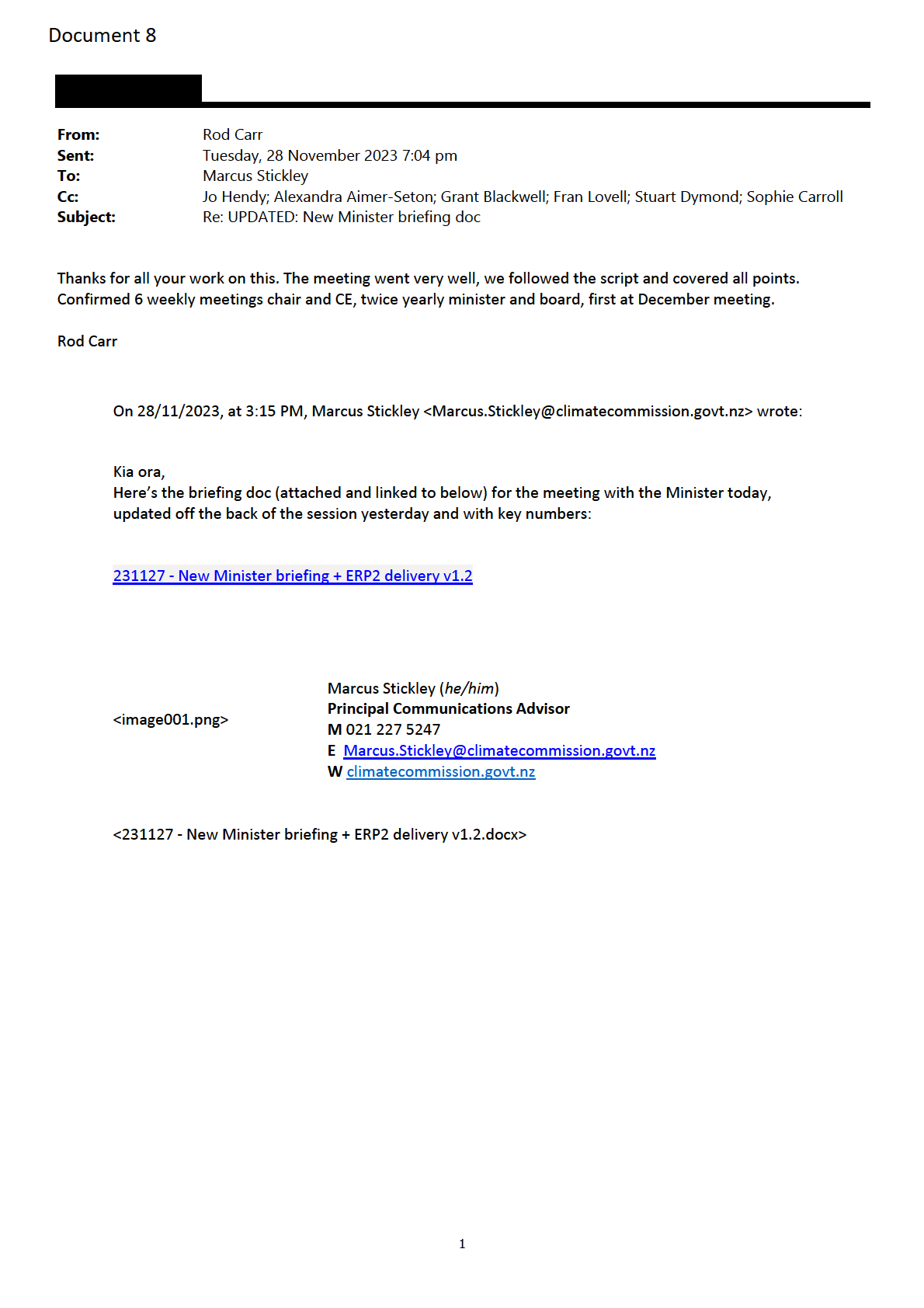
Document 9
Briefing with new Minister of Climate Change, Hon Simon Watts – 5pm, 28 November 2023
Contents
Goals ........................................................................................................................................................ 2
Key messages ........................................................................................................................................... 2
ERP2 messages......................................................................................................................................... 3
Key events or issues for your attention ................................................................................................... 3
Commission’s advice on second emissions reduction plan ............................................................. 4
Commissioner appointments .......................................................................................................... 4
Annual NZ ETS advice....................................................................................................................... 4
Judicial Review ................................................................................................................................. 4
NDC 5k request from previous Minister .......................................................................................... 5
Funding for agricultural emissions pricing....................................................................................... 5
Monitoring reports .......................................................................................................................... 5
Additional warming (back pocket only) ........................................................................................... 6
Questions for the Minister ...................................................................................................................... 6
Key numbers ............................................................................................................................................ 7
For the second emissions budget .................................................................................................... 8
Effort needed to meet the second emissions budget ..................................................................... 8
$$ health benefit of reducing emissions ......................................................................................... 8
GDP – cost of delay .......................................................................................................................... 8
$ investment in renewables (BCG report) ....................................................................................... 8
$ savings - replacing fossil fuels with renewables ........................................................................... 8
Gross electricity demand increase................................................................................................... 9
EVs now and needed by 2030.......................................................................................................... 9
Forests – scale of actual planting .................................................................................................... 9
Forests – demonstration path ......................................................................................................... 9
Cost containment reserve price ....................................................................................................10
Current NZU price ..........................................................................................................................11
% emissions outside of ETS, and covered by free allocation .........................................................11
APPENDIX I - Coalition agreements – what relates to the Commission’s work ....................................12
Goals
• Reinforce understanding of the Commission’s role, and our independence.
• Ensure Minister understands the key thrust of ERP2 advice – and his responsibilities under
the CCRA in relation to releasing the advice
• Ensure the Minister understands key upcoming events or issues, and where he will need to
take action/make decisions
• Ask questions about:
o Work from the Commission the Minister wants to better understand.
o How he understands his role and the Associate Minister role will work together
o The new Govt’s approach to climate policy, to aid our understanding.
o Driving action across portfolios
o How our Chair should engage with the Minister, eg frequency of meetings.
• Explain that our work programme is set out in legislation, and that we do not function like a
ministry or government agency where he can commission work directly at any time.
Key messages
•
Government has choices - The Government has choices about how to meet the country’s
climate goals. Policies that support reducing climate pollution provide direction to
businesses, communities and households open-up better choices for us all.
•
Commission supports action - We provide independent, evidence-based advice on the
direction of policy to the Government. How that direction is implemented is a political
choice for the Government
•
We monitor progress - The Commission’s monitoring role supports clarity and accountability
across the climate policy system. First monitoring reports coming mid-2024.
•
We deliver under the Act - We deliver what we are legislated to deliver, and we do so
efficiently and with good value for money
ERP2 messages
•
Choices must deliver - Whatever the mix of policies the Government decides on for
the second emissions reduction plan, they must add-up to meet our immediate climate
goals and keep the country on the path to net zero.
•
More, sooner, together - While the Commission’s analysis shows the country has
made progress, it is not on track to meet its climate goals for the end of this decade. This
risks missing out on benefits like new jobs, a more resilient economy and healthier
communities.
•
Forests, but … - Forests, which remove and store carbon from the atmosphere, are
critical to the pathway to achieving net zero – but forests planted now won’t make a
serious dent in the amount of offshore purchasing that Aotearoa needs to meet the
second emissions budget or the first NDC. The country needs to reduce greenhouse gas
emissions at source.
•
Energy Opportunities - Renewable, not fossil - The biggest opportunity is to replace
fossil fuels - like coal, gas and petrol - with renewable energy, to power our industries,
our buildings and our transport systems. This is a critical step where, in many cases,
investments made now in energy efficiency, electric vehicles, and renewable energy will
more than pay for themselves in the long term.
•
Agriculture options - There are clear options to achieve the further shifts needed to meet
the biogenic methane components of the 2050 target. With an effective emissions pricing
system for agriculture, new technologies, some land-use diversification, and on-farm
efficiency increases, the sector could make the changes needed to meet Aotearoa New
Zealand’s emissions reduction targets while limiting impacts on agricultural production.
Key events or issues for your attention
Commission’s advice on second emissions reduction plan
What ERP2 is - ERP2 provides a strategic direction of policy and recommendations on the most
urgent, highest priority actions required to achieve Aotearoa New Zealand’s 2026-2030 emissions
budget and enable the country to meet its future emissions reduction goals.
Act requires the Minister to present the advice, or … - You are required to present the advice in the
House no later than 10 working days after receiving it. We are required to make the advice publicly
available as soon as practicable after its presentation to the House but no later than 20 working days
after having provided it to you – this means it will be publicly released before the end of the year.
Govt must deliver - While the second emissions budget (for 2026-2030) has been set, the
Government needs a plan to deliver on it. As the Minister of Climate Change, you will be responsible
for delivering the next emissions reduction plan for Aotearoa New Zealand by the end of 2024.
Commissioner appointments
Two Commissioner appointments require a decision - There are two current Climate Change
Commissioners whose terms end mid-December 2023. You are responsible for the appointment of
Commissioners, supported by a nominating committee run out of the Ministry for the Environment.
The Commission understands that the nominating committee is in a position to provide
recommendations to you on appointments/reappointments with respect to these two positions.
Annual NZ ETS advice
• Due March 2024
• Each year, the Commission must provide advice to Minister on the New Zealand Emissions
Trading Scheme (NZ ETS), including recommending limits on units available each year in the
NZ ETS, and price control settings.
• The Commission’s advice on this will cover a rolling five-year period, with settings
recommended for each year.
• The purpose of our advice is to help ensure that the NZ ETS operates effectively and in
accordance with the emissions budgets, nationally determined contributions, and the 2050
target (as set out in the Climate Change Response Act 2002).
• The next NZ ETS auction is on 6 December
Our advice feeds into the Government’s annual update of the regulations that set limits and price
control settings for the NZ ETS.
Judicial Review
• A High Court decision on an application for a judicial review of the Climate Change
Commission’s first advice to the Government, Ināia tonu nei, was appealed by Lawyers for
Climate Action New Zealand (LCANZI) earlier this year. In the decision on the Judicial Review
released in November 2022, the High Court found in favour of the Commission on all
grounds.
• The previous Minister of Climate Change was also party to the case when it was heard in the
High Court.
• The appeal hearing was held in the Court of Appeal last week, from 21–23 November. A
decision has been reserved.
• The point of difference between the Commission and LCANZI is how quickly emissions
should be reduced between now and 2030. Under its obligations in the Climate Change
Response Act, the Commission’s advice must be based on delivering an economically and
technically achievable transition to net zero in an equitable and inclusive way by 2050.
NDC 5k request from previous Minister
• Under 5k of the CCRA, the previous Minister of Climate Change has asked us for advice to
help inform Aotearoa New Zealand's second Nationally Determined Contribution (NDC)
under the Paris Agreement.
• Aotearoa New Zealand’s second NDC must be set by 2025 and will be the country’s
international commitment to reducing climate pollution from 2031-2035.
• The Commission’s advice will be provided to the Minister of Climate Change by 31 December
2024.
• We will need to discuss the resources required to deliver this advice. It is critical that any
extra pieces of work are appropriately resourced to ensure the Commission is able to deliver
all of its statutory advice within the agreed and legislatively specified timeframes.
• The Commission is unable to begin the substantive work on this advice in the absence of
additional funding, though preliminary work such as scoping and planning for the advice can
begin.
Funding for agricultural emissions pricing
• In Budget 23, the Commission was appropriated $3 million per annum to support a possible
function for advising on agricultural emissions pricing. The Commission is investigating how
to add to its capability, irrespective of whether or when the Commission is asked to provide
further advice on emissions pricing.
• There is currently no dedicated capability, supporting tools or policy settings across the
public sector that would allow the efficient and effective pricing of agricultural emissions.
Some of the supporting pieces do exist, such as underlying data and models that could be
used, but they are spread through different agencies and have not been pulled together for
this purpose.
Monitoring reports
• A key purpose of the Commission’s monitoring role is to support transparency and
accountability across the climate policy system, and take an independent and evidence-
based look across the wider system and economy.
• Our first two progress reports are due for release in 2024. These will be the first reports in
an ongoing cycle.
Mitigation
• Our first annual progress report on mitigation is due in July 2024 and will assess the first
emissions reduction plan and Aotearoa New Zealand’s progress towards meeting the
emissions budgets and 2050 target.
Adaptation
• On the adaptation side, we must report on the progress of the Government’s national
adaptation plan every 2 years, with our first report due in August 2024.
Additional warming (back pocket only)
• IPCC has pulled together all the studies that look at what reductions in the different
greenhouse gases would limit warming to 1.5°C or well below 2°C as required under the
Paris Agreement.
• There is strong agreement that CO2 needs to go to zero by the middle of the century and net
negative in the second half of the century (any remaining emissions more than offset
through removals of CO2 from the atmosphere).
• For methane, levels don’t need to go to zero and the reductions are in the order of a quarter
to a half of recent levels by the middle of the century. This means there is ongoing warming
from methane, but it is less than today.
• If methane is only reduced to a level that adds no additional warming beyond what it is
already causing, we will miss our temperature targets unless faster or deeper reductions are
made in other gases.
• We have received submissions on the additional waming approach, and will consider them
as part of the target review.
Questions for the Minister
• Previously, the Chair, CE and Minister have met six weekly - How do you want to engage and
how frequently?
• What aspects of the Commission's work are most important for you to get across?
(Suggestions – any aspects of ERP2, ETS advice, monitoring and adaptation)
• To help the Commission’s work, what aspects of climate policy are likely to receive the most
focus from the Government? (Or any other question that will give insight into approach and
provide helpful context to the Commission.)
• How will the Minister and Associate Minister roles work together?
• Has the Minister considered how he will drive action across portfolios? Currently there is the
Inter-Agency Executives Board and the Climate Response Minister's Group.
• It would be helpful to understand the division of the Climate Change portfolio across a
Minster and an Associate Minister – especially with an Associate Minister in Cabinet.
Key numbers
For the second emissions budget
•
43.5 MtCO2e – estimated total quantity of emissions reductions
needed
• the largest share (around 40%) is expected
to come from energy and industry,
totalling
17.4 MtCO2e • the transport, agriculture, and forestry sectors
are each expected to deliver reductions of
7-8 MtCO2e
• the remaining
3.3 MtCO2e is expected to come
from waste and F-gases
Effort needed to meet the second emissions budget
•
20.7 MtCO2e - amount of emissions reductions required to meet EB2, in addition to policies
and measures already in place.
•
14.0 MtCO2e – amount needed if further planned policies and measures from first emission
reduction plan were put in place
$$ health benefit of reducing emissions
Acting to reduce emissions can provide health benefits, including improving mental health for young
people and addressing the causes of physical health challenges related to cold, damp housing
and air pollution, which research suggests costs Aotearoa New Zealand
$15.6 billion per year in
health impacts
GDP – cost of delay
We assessed that the level of GDP could be around
1.2% lower in 2050 than it would be otherwise.
Delaying key actions like transitioning to electric vehicles and embedding more efficient farm
practices could result in the level of GDP in 2050 falling by around
2.3%.
$ investment in renewables (BCG report)
$42 billion by 2030 total across electricity generation, transmission and distribution including BAU
spend, network upgrades/enhancements, and to bring things up to current standard
$ savings - replacing fossil fuels with renewables
The Commission’s analysis shows that by the 2040s, replacing fossil fuels with renewable electricity
in areas like transport and heating could save businesses and households in Aotearoa New Zealand
around
$2 billion each year.
Gross electricity demand increase
Gross electricity demand has been relatively stable over the past two decades but is projected to
increase
26% by 2035 and
65% by 2050, compared to 2021.
Each year from 2025, generation that can supply over 1 TWh per year will need to be built to meet
anticipated demand. For scale, this is equivalent to around two very large wind farms being
completed every year (although we expect a mixture of renewable generation types, including
geothermal and solar).
EVs now and needed by 2030
•
90,000 EVs (just cars) at the moment.
• By 2030 we've said we need to have
~620,000 - which means we need to grow the current
number of EVs by around 7x in the next 6 years. Even then EVs will only be 16% of the car
fleet.
• By 2035 EVs there will need to be
1.2 million EVs - or a 13x increase.
Forests – scale of actual planting
• New exotic forest planting is currently proceeding well above earlier expectations:
over
64,000 hectares was estimated to be planted in 2022, compared with the government’s
baseline projection of around
32,000 hectares per year between 2022 and 2030 when the
emissions budgets were set.
• If similar rates were sustained, carbon removals from forestry would significantly exceed
sector sub-targets for the second and third emissions budgets.
Forests – demonstration path
• In the updated demonstration path, total exotic afforestation over the period 2021–2035
increased from
380,000 ha to 500,000 ha.
• Total native afforestation decreased in the updated demonstration path from
300,000 ha to
280,000 ha for the same period.
• The updated demonstration path still assumes that native afforestation rates reach
25,000
ha per year by 2030.
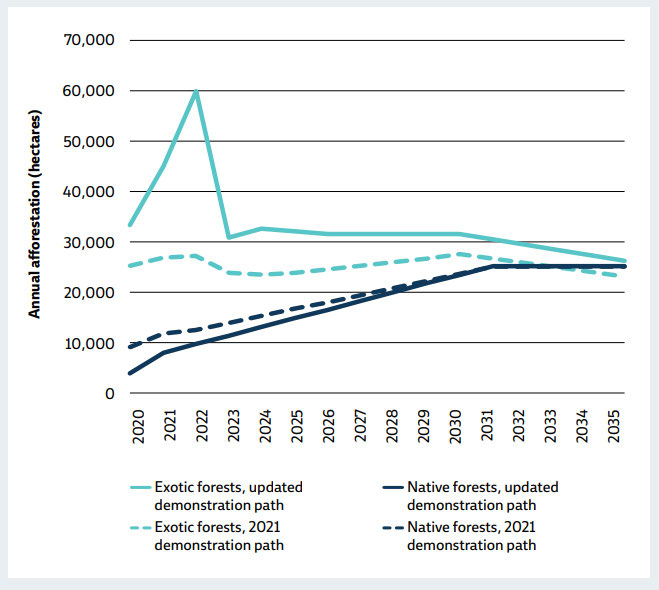

Cost containment reserve price
Current NZU price
• Spot NZUs opened at
$72.75 bid and
$72.80 offered on CommTrade this morning, after last
fixing at $72.75.
% emissions outside of ETS, and covered by free al ocation
• Industrial allocation is taking up an increasingly large portion of the NZ ETS cap and the units
available for auction.
• In 2022 more units were released into the market than the ETS cap and then ended up being
surrendered – i.e., additional supply from the CCR added to the surplus when the intention
was for this to be used up.
• In 2023 no auctions have cleared – complete opposite of the year before, when everything
including CCR was sold!
• Units currently in regulation to 2028, show that IA would increase to taking up to 46% of
total IA + base auction supply volumes.
ETS cap
ETS limit
ETS base
ETS cost
Industrial
Official
on units
auction
containme
allocation (IA) Surrender
(i.e., all
volumes
nt reserve
s
auction
volume
volumes +
CCR
Industrial
allocation)
2022
32m
34.5m
19.3 (sold)
7m (sold)
6.1m
31.5
(16% of ETS
cap; 24% of
base auction +
IA)
2023
30.8
29.2m
15m
8m
NA
NA
available 0 available, 0 (6.2m
sold to
sold to
estimate)
date
date
(17% of cap;
29% of base
auction + IA)
•
APPENDIX I - Coalition agreements – what relates to the Commission’s
work
Note: This is background information only summarising from the coalition agreements. It does not
contain policy that individual parties campaigned on.
Overall system
Deliver Net Zero by 2050 including by doubling New Zealand’s renewable electricity and supporting
new technology to reduce agricultural emissions.
Stop the current review of the ETS system to restore confidence and certainty to the carbon trading
market.
Transport
National’s commitment to supercharge electric vehicle infrastructure with a comprehensive,
nationwide network of 10,000 public EV chargers by 2030 will specifically take into account ACT’s
concern that there be robust cost benefit analysis to ensure maximum benefit for government
investment
Repeal the Clean Car Discount.
Work to replace fuel excise taxes with electronic road user charging for all vehicles, starting with
electric vehicles.
Work with Auckland Council to implement time of use road charging to reduce congestion and
improve travel time reliability.
Cancel Auckland Light Rail and Let’s Get Wellington Moving and reduce expenditure on cycleways
Build infrastructure with 13 new Roads of National Significant and four major public transport
upgrades.
Facilitate the development and efficiency of ports and strengthen international supply networks
Progress further work examining connecting the railway to Marsden Point and Northport from the
Northern Main Truck Line. Progress the detailed business case for a dry dock at Marsden Point to
service domestic and international shipping needs and to support our Navy vessels, with
investigation of funding options including commercial partnerships
Infrastructure/urban systems
Legislate to make the MDRS optional for councils, with the need for councils to ratify any use of
MDRS, including existing zones.
Repeal the Natural and Built Environment Act 2023 and the Spatial Planning Act 2023 by Christmas
Amend the Resource Management Act 1991 to:
o Make it easier to consent new infrastructure including renewable energy, allow farmers to farm,
get more houses built, and enhance primary sector including fish and aquaculture, forestry, pastoral,
horticulture and mining.
o Streamline the plan preparation process in Schedule 1 of the RMA.
o Simplify the planning system and related statutes including the Public Works Act and the Reserves
Act.
o The Parties commit to establish a fast-track one-stop-shop consenting and permitting process for
regional and national projects of significance. The process will include a referral by Ministers for
suitable projects. A Bill to introduce this process and make other essential statutory amendments
will have its first reading as part of the government’s 100 day plan.
Establish a National Infrastructure Agency under the direction of relevant Ministers, to coordinate
government funding, connect investors with New Zealand infrastructure, and improve funding,
procurement, and delivery to: o Prioritise regional and national projects of significance. o Facilitate
or procure funding for regional and national projects of significance. o Procure from government
agencies for appropriate Crown projects. o Oversee procurement from the private sector.
Agriculture
Maintain a split-gas approach to methane and carbon dioxide through to 2050 and review the
methane science and targets in 2024 for consistency with no additional warming from agricultural
methane emissions.
Enable farmers and landowners to offset sequestration against their on-farm emissions.
Liberalise genetic engineering laws.
Progress work to recognise other forms of carbon sequestration, including blue carbon.
Incentivise the uptake of emissions reduction mitigations, such as low methane genetics, and low
methane producing animal feed.
Support Farm Environment Plans administered by regional councils and targeted at a catchment
level.
Adopt standardised farm level reporting
Energy
Update the Crown Minerals Act 1991 to clarify its role as promoting the use of Crown minerals.
Repeal the ban on offshore oil and gas exploration
Stop work notice: Lake Onslow Pumped Hydro
Commission a study into New Zealand’s fuel security requirements.
Investigate the reopening of Marsden Point Refinery. This includes establishing a Fuel Security Plan
to safeguard our transport and logistics systems and emergency services from any international or
domestic disruption.
Examine transmission and connection pricing to facilitate cost effective connection of new
renewable generation resources, both on-shore and off-shore.
Plan for transitional low carbon fuels, including the infrastructure needed to increase the use of
methanol and hydrogen to achieve sovereign fuel resilience.
Future-proof the natural gas industry by restarting offshore exploration and supporting
development of hydrogen technology to produce hydrogen from natural gas without co-production
of CO2.
Ensure that climate change policies are aligned and do not undermine national energy security.
Ensure the government’s energy settings allow for the exploration of natural geological hydrogen in
New Zealand, to maximise future energy resilience.
Investigate the strategic opportunities in New Zealand’s mineral resources, including vanadium, and
develop a plan to develop these opportunities.
Māori engagement
Require the public service departments and Crown Entities to communicate primarily in English -
except those entities specifically related to Māori.
Confirm that the Coalition Government does not recognise the United Nations Declaration on the
Rights of Indigenous Peoples (UNDRIP) as having any binding legal effect on New Zealand.
Conduct a comprehensive review of all legislation (except when it is related to, or substantive to,
existing full and final Treaty settlements) that includes “The Principles of the Treaty of Waitangi” and
replace all such references with specific words relating to the relevance and application of the
Treaty, or repeal the references.
Further notes:
One thing to note is the agreements only include policies relevant to NZF or Act so either giving a
commitment to them or modifying a National Party policy.
We might see more emerge through media over the next few weeks of the Government's overall
climate change position.
Further policy commitments are likely to be confirmed in the Speech from the Throne which will be
given when Parliament resumes which typically includes the key commitments of the main
governing party.
The speech from the throne is usually the day after the first day of the sitting of Parliament which
has been scheduled for 5 December.
Document 10
Staff Meeting 30 November notes
First meeting with new Minister
Rod was invited to a first meeting with the new Minister of Climate
Change, Simon Watts, on Tuesday evening this week.
Jo and Alie Aimer-Seton accompanied Rod to the meeting.
As well as being an introductory meeting, it was also an opportunity for
Rod to deliver the Commission’s ERP2 advice to the new Minister.
This is a huge milestone for us as a Commission and represents many
months of hard work by so many of us here. Thank you to all of you who
worked on the ERP2 in some capacity – well done!
According to Rod the meeting went very well. He was able to cover all
of the points we had identified as being important for this first
engagement.
The Minister agreed to six weekly meetings with the chair and CE; and
twice yearly meetings of the minister and the Board, with the first of
these to take place at the Board’s December meeting.
I want to thank Marcus and others that helped prepare Rod and Jo for
this important first meeting. We only had a day’s notice and it was a
great example of how we can pivot to meet unexpected urgent requests
when we need to.
Staff Meeting 30 November notes
Staff Meeting 30 November notes













